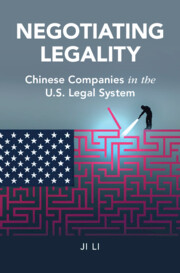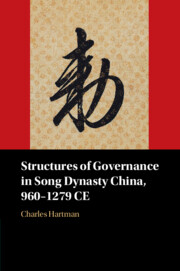Refine search
Actions for selected content:
62 results
1 - The Court That Failed
-
- Book:
- The Kansas Court of Industrial Relations
- Published online:
- 26 July 2025
- Print publication:
- 14 August 2025, pp 1-32
-
- Chapter
- Export citation
2 - Ideological Modules for Diagnosing Disorder
- from Text 2 - Memorial Presenting Emperor Hongzhi with the Supplement
-
-
- Book:
- Chinese Statecraft
- Published online:
- 17 July 2025
- Print publication:
- 31 July 2025, pp 21-36
-
- Chapter
- Export citation
3 - Political Tensions and the Democratic Press
- from Part II - Democracy and the Press Function
-
-
- Book:
- The Future of Press Freedom
- Published online:
- 25 July 2025
- Print publication:
- 24 July 2025, pp 28-37
-
- Chapter
-
- You have access
- Open access
- HTML
- Export citation
The world in a court: how the International Court of Justice’s organizational practices promote stability in a contested field
-
- Journal:
- Law & Society Review / Volume 59 / Issue 1 / March 2025
- Published online by Cambridge University Press:
- 10 February 2025, pp. 138-171
- Print publication:
- March 2025
-
- Article
- Export citation
4 - Trilogues
-
- Book:
- Trilogues
- Published online:
- 09 January 2025
- Print publication:
- 23 January 2025, pp 103-139
-
- Chapter
- Export citation
4 - Theories of Regulation
- from Part II - Design, Dynamics and Implementation
-
- Book:
- An Introduction to Law and Regulation
- Published online:
- 22 November 2024
- Print publication:
- 28 November 2024, pp 119-146
-
- Chapter
- Export citation
16 - Economic Liberalism and Rights in the Nineteenth Century
- from Part II - Postrevolutionary Rights
-
-
- Book:
- The Cambridge History of Rights
- Published online:
- 22 January 2025
- Print publication:
- 28 November 2024, pp 384-406
-
- Chapter
- Export citation
Chapter 35 - Climate change
- from Part 4 - The new agenda: Globalisation and global challenges
-
-
- Book:
- An Introduction to International Relations
- Published online:
- 31 August 2024
- Print publication:
- 12 August 2024, pp 466-478
-
- Chapter
- Export citation

Negotiating Legality
- Chinese Companies in the US Legal System
-
- Published online:
- 13 June 2024
- Print publication:
- 27 June 2024
Chapter 1 - Introduction
-
- Book:
- Freedom and Power in Classical Athens
- Published online:
- 04 April 2024
- Print publication:
- 11 April 2024, pp 1-17
-
- Chapter
-
- You have access
- Open access
- HTML
- Export citation
1 - Religious Ethics and Obligations to Others
-
- Book:
- On Helping One's Neighbor
- Published online:
- 04 April 2024
- Print publication:
- 14 March 2024, pp 1-42
-
- Chapter
- Export citation
11 - Evaluating the Competing Arguments Regarding the Contemporary Use of Public Nuisance in Mass Tort Litigation
-
- Book:
- Public Nuisance
- Published online:
- 02 November 2023
- Print publication:
- 16 November 2023, pp 230-257
-
- Chapter
- Export citation
New governance of the digital health agency: a way out of the joint decision trap to implement electronic health records in Germany?
-
- Journal:
- Health Economics, Policy and Law / Volume 19 / Issue 2 / April 2024
- Published online by Cambridge University Press:
- 11 September 2023, pp. 269-288
-
- Article
-
- You have access
- Open access
- HTML
- Export citation
2 - Constitutionalism and the Counterpopular Dilemma
-
- Book:
- The Law of Freedom
- Published online:
- 06 July 2023
- Print publication:
- 20 July 2023, pp 51-89
-
- Chapter
- Export citation
The ordoliberal internet? Continuity and change in the EU’s approach to the governance of cyberspace
-
- Journal:
- European Law Open / Volume 2 / Issue 1 / March 2023
- Published online by Cambridge University Press:
- 29 June 2023, pp. 106-127
-
- Article
-
- You have access
- Open access
- HTML
- Export citation
2 - Analysing the EU
- from Part I - Setting the Scene: Origins, Analytical Perspectives and Institutions
-
- Book:
- The Politics of the European Union
- Published online:
- 30 March 2023
- Print publication:
- 20 April 2023, pp 28-45
-
- Chapter
- Export citation
5 - The Technocratic–Confucian Continuum
- from Part I - Dual Faces of the Song State
-
- Book:
- Structures of Governance in Song Dynasty China, 960–1279 CE
- Published online:
- 30 March 2023
- Print publication:
- 06 April 2023, pp 115-140
-
- Chapter
- Export citation
Introduction
-
- Book:
- Structures of Governance in Song Dynasty China, 960–1279 CE
- Published online:
- 30 March 2023
- Print publication:
- 06 April 2023, pp 1-24
-
- Chapter
- Export citation

Structures of Governance in Song Dynasty China, 960–1279 CE
-
- Published online:
- 30 March 2023
- Print publication:
- 06 April 2023
Authoritarian Gender Equality Policy Making: The Politics of Domestic Violence in Russia
-
- Journal:
- Politics & Gender / Volume 19 / Issue 4 / December 2023
- Published online by Cambridge University Press:
- 02 March 2023, pp. 1035-1060
-
- Article
-
- You have access
- HTML
- Export citation
